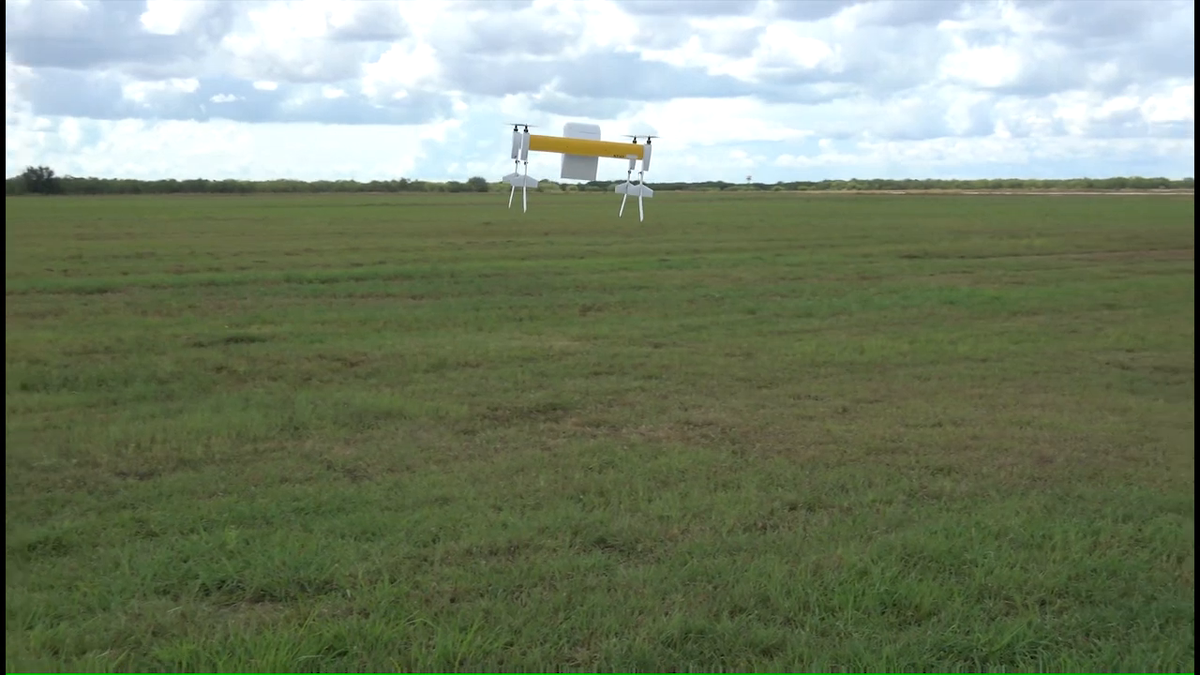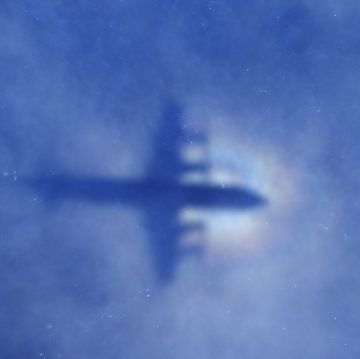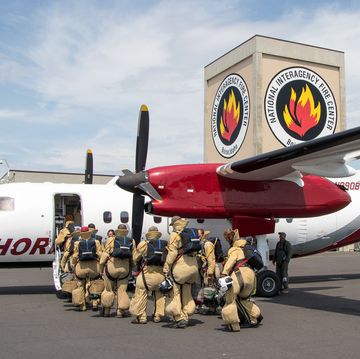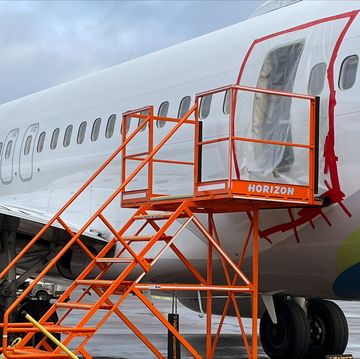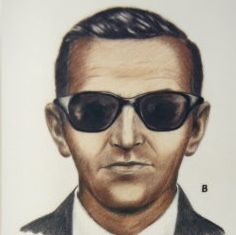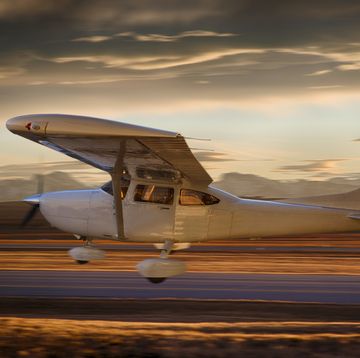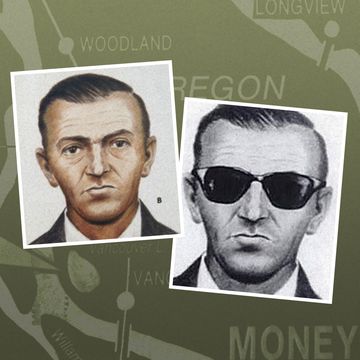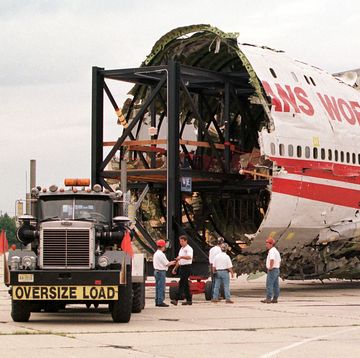The official investigation into the explosion of TWA Flight 800 in 1996, which killed 230, concluded that a fuel tank had ignited from within, but never determined what sparked the explosion. (Dozens of airplanes have suffered similar events, and the safety regulations governing fuel tanks changed in 2008.) But now, all these years later, a new documentary, TWA Flight 800, claims that a missile or bomb took down the plane—and the U.S. government has been covering it up.
"It was either a terrorist attack that they wanted to ignore, or an accident as a result of a military operation that went wrong," Hank Hughes, a former National Transportation Safety Board investigator and driving force behind the film, told ABC News.
What would you have to believe to accept the idea of a 17-year-old sprawling government cover-up? We look back at the original NTSB report to see what it says, and who would have had to lie about forensic tests or doctored evidence. Here's a refresher on what the report says, why the original, simpler explanation is still the most likely.
Blast Holes
Investigators reconstructed and analyzed virtually the entire structure of the stricken airliner. The work revealed 196 blast holes in the airplane's structure. So how did the investigators figure that an internal gas tank explosion caused this damage, instead of a missile or bomb?
The NTSB's metallurgists requested that Boeing conduct the tests (and Boeing had no motive to reach the conclusion that a defect in its own equipment, rather than an act of violence, caused the blast). Its engineers created test plates and fired fragments at them at high and low velocities. An antiaircraft missile warhead detonates close to its target, spraying shrapnel at high speeds into the aircraft to destroy it. A bomb made with high-energy explosives would also hurl metal, this time from the inside out, at higher velocities than an inadvertent gas tank detonation.
These tests indicated that high-speed fragments leave particular signs behind, like deformations on the edges and melted parts of the walls of the hole. High-speed impacts leave little surface deformation. In the TWA 800 tests, all but two of the 196 holes exhibited signs of low-velocity penetration, and the remaining two holes showed signs of both. One of these mystery holes—just 3/16-inch diameter—was examined in the Safety Board's Materials Lab. "No evidence of melted and resolidified metal was noted on any portion of the hole wall," the report states.
All the holes near the wing, where the fuel tank that exploded was located, were low-velocity impacts. About 95 percent of the airplane was reconstructed, and the missing parts were too small to hide bomb or missile damage.
To fake these lab results would require a cadre of engineers at Boeing, as well as the NTSB to be in on the conspiracy or be willing to sit quietly as their tests were rigged. Either way, there is a slew of outside voices involved with the tests that could contradict the government's story.
Radar
The east coast of the United States is covered by plenty of radar. The area where TWA 800 went down was in the range of three long-range radar sites, each with a 200 nautical mile radius, as well as five airports and one radar operated by helicopter manufacturer Sikorsky in Shelton, Conn. The others used direct returns. NTSB investigators also used radar data from the U.S. Air Force's 84th Radar Evaluation Squadron.
There are two kinds of radar returns, primary and secondary. Primary returns mean the radar waves are reflected off the aircraft. Secondary means the signal came from the transponders in the aircraft. The one in Connecticut tracked only the doomed airliner's transponder signals; all the others were primary returns.
"The Safety Board's examination of all the available radar data revealed no sequence of primary or secondary radar returns that intersected TWA Flight 800's position at any time, nor did it reveal any radar returns consistent with a missile or any other projectile travelling toward the airplane," the report says.
A lot of radar means a lot of people sitting in front of screens. The data is all recorded, at each location. Hiding a military warship (deployment records indicate there were none around that night) or a missile track would mean somehow co-opting or coercing every radar operator on duty that night—a daunting task, especially if it was done to cover up an inadvertent military shoot down or unexpected terrorist attack.
To be fair, many conspiracy theorists have used the existing radar data to back up their own ideas of what brought the airplane down—especially the behavior of some boats and radar anomalies from one of the radar sites that registered objects in the area moving at high speeds, then vanishing. (These were judged to be phantom returns from building reflections.) None of these radar returns show anything in the air intersecting the path of the airliner, or any vessel behaving in an overtly suspicious way. (See pages 89–94 in the original report.)
Fuel Tanks
As scary as a missile or bomb attack might be, the idea that the fuel tank exploded on its own can be considered even scarier. The biggest leap for investigators back in 1996 was to prove that a fire in the central wing tank (CWT) could have caused an explosion that brought down the airplane.
First, those investigating the tanks had to rule out that the explosion started inside that tank, as opposed to a missile or bomb shrapnel piercing it from outside. There is no physical evidence of a bomb blast—no perforations of the fuselage, the fuel tank, or the bodies of the victims. Fragments of a missile warhead would not reach the fuel tank, and a joint NTSB and British Defense Evaluation and Research Agency investigation found there was no evidence of an explosive charge nested inside the tank by a saboteur. (Such a charge would produce hot gas damage and pockmarks that were not found.)
At the time, there was very little engineering work done regarding fuel tank flammability. The NTSB investigation spawned a team of experts dedicated to studying the issue, which within aviation circles was more heated than the conspiracy chatter: In the aftermath of the crash, any fix that investigators suggested could lead to regulations that cost millions to implement.
The investigators studied it all: the chemistry of the fuel, how the fuel/air vapor could ignite, how the flames could move through the wing after bursting from the tank. They established two independent models to simulate the pressure differences inside the wing, a key part of how the fiery fluid would spread. The Safety Board contracted the University of Nevada to analyze the properties of jet fuel vapor. The team ran hundreds of simulations, brought in Boeing engineers to assess the damage of the airliner's remains, and solicited the opinion of an explosives dynamics expert at the California Institute of Technology. There were flight tests done at the same temperature and conditions as TWA Flight 800 and full-scale fuel tank explosion tests conducted in England.
The litany above actually leaves out tests and academic efforts to understand what happened. All this is to say: The study of TWA 800 was not a sealed-off investigation done by a cadre of bureaucrats. The results were meant to be published, shared, and serve as the foundation of new regulations.
In the end, NTSB found that TWA Flight 800 would not have perished without a flammable fuel/air mix in its central wing tank, but investigators were never sure what sparked the explosion in the first place—the closest they got was "a short circuit outside of the CWT that allowed excessive voltage to enter it through electrical wiring associated with the fuel quantity indication system."
The investigation into TWA 800 inspired new FAA regulations in 2008 that required passenger airplanes to have equipment that replaces oxygen inside fuel tanks with an inert gas, like nitrogen. To believe a cover-up implies that an entire industry was duped into believing fuel tanks could become bombs if the fuel/air mix was just right. Of course, there have been dozens of similar explosions before and (in foreign carriers) after TWA Flight 800, making the accepted theory all too believable.
Joe Pappalardo is a contributing writer at Popular Mechanics and author of the new book, Spaceport Earth: The Reinvention of Spaceflight.

